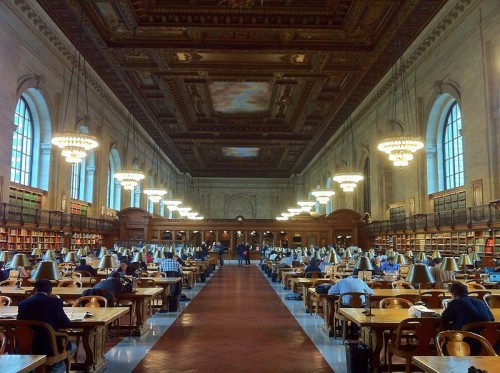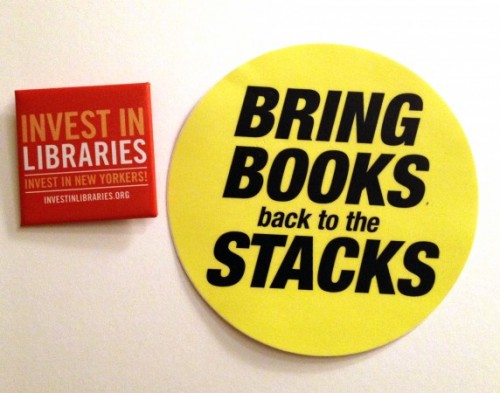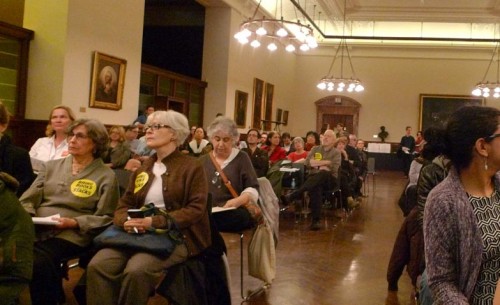Monthly Archives: April 2015
Did you know that NYPL’s Rose Reading Room is not a designated NYC landmark?
While New York has 117 designated interior landmarks, the Rose Reading Room is not one of them.
Completed in 1911, the 42nd Street Library designed by Carrère and Hastings is one of New York’s most splendid civic monuments. As the Landmarks Preservation Commission’s 1967 designation report noted, “This building comes closer than any other in America to the complete realization of Beaux-Arts design at its best. It somehow managed to keep that light airy quality, so often seen only in architectural drawings, so rarely achieved in execution.”
But the 1967 individual landmark designation only covers the exterior of the building. While the exceedingly fine marble exterior with its deep, triumphal arch portico boasts one of the finest facades along Fifth Avenue, for library patrons, its greatest splendors await inside. In 1974, the Landmarks Preservation Commission designated Astor Hall, the Main Staircase, and the McGraw Rotunda interior landmarks, the very first interior spaces to receive protection under the revised landmarks law.
Occupying nearly half an acre and (until recently) resting atop a mountain of books, the Rose Reading Room stands as the crown jewel of the New York Public Library. Here New Yorkers of all walks of life sit huddled together, lost in the pursuit of knowledge. As Paul LeClerc, former NYPL president once remarked, ”its essence is the most pluralistic, democratic access imaginable. The only criterion one needs to get in is curiosity.”
Although the NYPL administration insists they are responsible stewards of the 42nd Street Library, only landmark designation offers safeguards against insensitive alterations and additions. In 2013, preservationists requested interior designation for the remaining public rooms in the 42nd Street Library. For whatever reason, the Landmarks Preservation Commission declined to calendar these rooms for interior landmark consideration.
Now that the Landmarks Preservation Commission has a new Chair and four new Commissioners, LPC should move to ensure these sumptuously decorated rooms are given the landmark status they clearly deserve.
In honor of the 50th anniversary of the passage of New York City’s landmarks law, NYPL should formally request interior landmark designation for all the public rooms in the 42nd Street Library, including the Rose Reading Room, Bill Blass Catalog Room, Gottesman Exhibition Hall, DeWitt Wallace Periodicals Room, Celeste Bartos Forum, and other important rooms in the New York Public Library’s 42nd Street building.
Last month, NYPL officials held a public meeting to review aspects of plans for major renovations to the 42nd Street and the Mid-Manhattan Libraries. As can be seen from the agendas and pre-determined questions here, the meeting was structured to channel discussion narrowly rather than to encourage broad public discussion of options. The meeting left much to be desired.
Ken Weine, Vice-President of Marketing and Communications at NYPL, has promised more public forums in the future. In order to facilitate a more productive dialogue, the Committee to Save the New York Public Library believes the following steps are necessary:
• Agendas and questions under consideration should be circulated prior to public meetings.
• The criteria for architect selection must be open to public discussion.
• The short list of architects must be publicly announced.
• The instructions and programs provided to the architects must be open to public discussion prior to being given to the architects.
• The return of books to the stacks along with the necessary renovation to the stacks must be publicly addressed with detailed cost comparisons of construction and operational alternatives made open to public discussion. To that end the NYPL must release internal and externally generated cost estimates.
NYPL squandered at least $18 million on the defeated Central Library Plan. Had a rigorous public review occurred millions in taxpayer dollars would not have been wasted. Before NYPL spends the remaining $151 million allocated by the city on future capital projects, they must take every available opportunity to listen to the public and incorporate feedback into their plans.
When John Shaw Billings, the first director of the New York Public Library, first conceived the 42nd Street Library, he made sure each version of the instructions given to the architects was open to public scrutiny and discussion. The great research library New Yorkers have enjoyed for a century is the result of that open search for the best solution. We need the same commitment to transparency and open consideration of options from our library leaders today.
Big changes are underway at the New York Public Library. Major renovations at the Mid-Manhattan Library and the 42nd Street Library will have a profound impact on how these popular libraries are used. Decisions made now will determine the quality of our libraries for many years. Please join us in urging NYPL and the city officials who control taxpayer contributions to its capital budget to truly open the planning process to all citizens.
Image courtesy of Melville House Books.
Last week, the New York Public Library hosted a public meeting about its proposed “Midtown Campus Renovations.” Library lovers from across the city converged on the Edna Barnes Salomon Room in the 42nd Street Library to voice their concern for the two most popular libraries in the NYPL system.
NYPL President Anthony Marx made brief opening remarks before handing over the presentation to Elliot Felix, the director of Brightspot Strategy. It’s unclear whether Brightspot is involved in the planning of the Midtown library renovations, a project library leaders have frequently described as “staff driven.” Mr. Felix touted NYPL’s work soliciting public feedback through numerous focus groups and an online survey. However, these results are not available to the public.
Very few details of the library’s plans were divulged. Instead, Mr. Felix referred to vague goals of ensuring “access to materials” and providing additional “quiet spaces.” Shortly afterwards, meeting participants divided into break-out groups focused on research, core services, PK-12 education, adult education, or small business. Fortunately, CSNYPL members were present in each group. Most were led by Brightspot consultants rather than NYPL librarians. Participants were instructed to respond to narrowly defined questions, and responses were reduced into short and sometimes misleading summaries written on flip pads.
Anne Thornton, director of research services, greeted the research group, but immediately turned the proceedings over to Elliot Felix. Asked to describe an ideal research experience, scholars insisted it was imperative to have the books on site, to be able to read them in a quiet space, and to have knowledgeable librarians available in the reading room. Others stressed the key element of time in research. When there may be days before an additional book is in the researcher’s hands, the original creative impetus is dimmed, if not lost. For researchers from out of town, time is of the essence and availability must be predictable for them. The last speaker praised the efficiency of the stacks and how they ensured prompt delivery to the reading room. Researchers, she insisted, would be better served with more materials available on-site. The need to return the books to the stacks was mentioned by almost every speaker; many participants also wore highly visible yellow sticks which stated “Bring Books back to the Stacks.”
In the core service group, attendees voiced unanimous support for rehabilitating the 42nd Street book stacks and keeping books in both libraries. A Guttman Community College faculty member stressed the need for her students to quickly access books at the 42nd Street library. There was a broad consensus on the need for preserving “quiet space” in libraries, hiring more librarians with M.L.S degrees, and providing ESL classes in Mid-Manhattan. Several members urged NYPL to adopt a more transparent decision making process, however, the Brightspot facilitator adamantly refused to include this point in her summary.
Those present in the business group began by observing that the questions posed by the facilitator ignored key questions about the fate of the Science Industry and Business Library (SIBL) at 34th Street and the need to maximize the number of books quickly available to mid-town library users. They requested support for more private space, meeting rooms, and business counseling programs. Nearly everyone voiced their opposition to the sale of SIBL. When pressed to explain what would happen to the Science and Industry component of SIBL, it was revealed NYPL will no longer provide a comprehensive science and industry collection. SIBL librarian Kristin McDonough forthrightly explained NYPL’s current plans to divide and scatter SIBL functions and accurately reported participant comments to the whole group. This made a striking contrast to skewed and incomplete flip pad notes made by the Brightspot facilitator.
The carefully controlled and choreographed meeting was evidently designed to give the impression NYPL leaders are engaging with the public. Facilitators never bothered to distinguish between the Mid-Manhattan Library and the 42nd Street Library when summarizing group feedback, even though many respondents specified how these buildings should be used. Dividing the public into separate groups and the use of Brightspot “facilitators” kept participants at arm’s length from library officials and this undermined the goal of open dialogue.
The demand to return books to the stacks—by far the most common request—was entirely ignored.
At the end of the meeting, Ken Weine (NYPL’s Vice President of Communications) promised additional public meetings as plans progress.
NYPL officials must make a real effort to incorporate feedback from library patrons into their plans for the 42nd Street and Mid-Manhattan Libraries. The public has repeatedly and forcefully expressed its preference to keep as much of the NYPL research collection quickly accessible in the 42nd Street Library, to support and rebuild library staff, and to make prudent use of existing facilities. Future NYPL actions will show us if Library leaders are listening.



